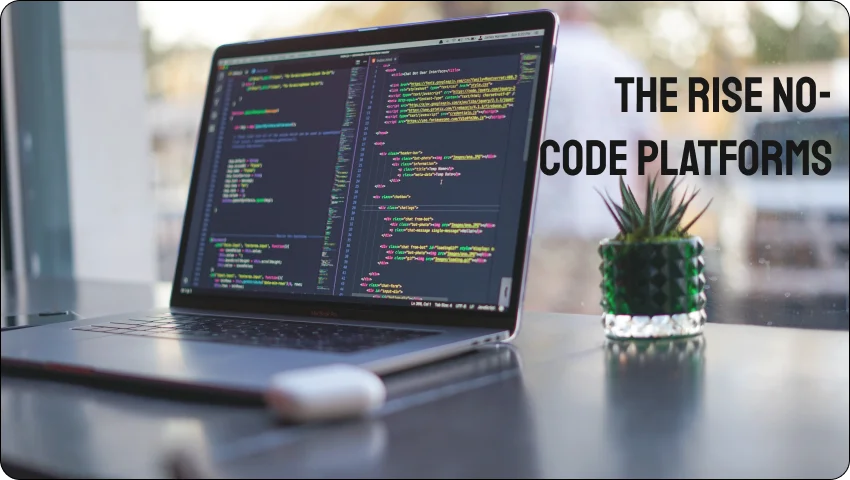Understanding No-Code Platforms
No-code platforms are revolutionizing software development by making it accessible to everyone, regardless of technical expertise. These platforms enable individuals and businesses to create apps, websites, and automated workflows without writing a single line of code.
Software development is revolutionized by no-code tools, achieving speeds up to ten times faster than traditional methods and requiring 70% fewer resources. No-code platforms offer intuitive interfaces, drag-and-drop functionality, and pre-built components that abstract away the complexities of traditional coding. This allows users to concentrate on shaping and executing their ideas without requiring specialized technical expertise. With no-code platforms, users can swiftly and effectively develop a variety of applications, such as websites, mobile apps, workflow automation, and beyond.
Here’s how no-code platforms are shaping the future of software development:
- Empowering Non-Developers
No-code platforms lower the barrier to entry for software creation. Entrepreneurs, small businesses, and professionals from non-technical backgrounds can now build powerful solutions tailored to their specific needs. - Accelerating Development
With intuitive drag-and-drop interfaces and prebuilt templates, no-code platforms significantly reduce development time, allowing users to launch projects faster and at a lower cost. - Fostering Innovation
By removing technical hurdles, no-code tools encourage creative problem-solving and innovation, enabling individuals to bring their ideas to life without relying on a dedicated development team. - Enhancing Collaboration
These platforms bridge the gap between developers and non-developers, fostering collaboration across teams. Designers, marketers, and product managers can contribute directly to the development process. - Use Cases Across Industries
No-code platforms are versatile, with applications ranging from e-commerce stores and internal tools to CRM systems and workflow automation, making them a valuable asset across various sectors. - Challenges and Limitations
While no-code platforms are powerful, they may not suit complex or highly customized projects. Additionally, users should be cautious about vendor lock-in and ensure scalability as their needs grow.
No-code Platforms and Democratization
The essence of the no-code trend lies in its ability to empower general business users to create solutions previously reserved for specialists. This democratization of technology transforms ordinary individuals into citizen developers, unleashing a wave of innovation across industries.
A study conducted by Mendix indicates that a quarter of their no-code developer community lacked previous coding skills. Furthermore, 70% of these newcomers were capable of developing applications in less than a month.
The critical role of no-code technologies is underscored by forecasts suggesting they will account for 70% of all new business applications by 2025. With a valuation of $7.61 billion in 2021, the no-code market is expected to surge to $36.43 billion by 2027.
Benefits of No-code Development
In today’s business environment, even well-equipped IT departments find it challenging to stay ahead. The demand for new applications and solutions is relentless, but traditional development cycles can bog down innovation. Here’s where no-code development sweeps in, offering a lifeline to businesses and developers alike by simplifying and accelerating the digital transformation process.
While no-code platforms offer extensive technical benefits, their impact on various business roles highlights their transformative nature.
Addressing Challenges of No-code Adoption
Despite the numerous benefits of no-code platforms, some organizations hesitate due to concerns about security, customization limitations, and integration with legacy systems.
-
Security standards on no-code platforms are robust, often complying with industry regulations.
-
Customization, while initially seeming limited, often includes advanced options that can meet most needs through configuration rather than coding.
-
Integration tools are continually improving, with many platforms offering extensive APIs that facilitate seamless interactions with existing IT infrastructure.
The rise of no-code platforms represents a paradigm shift, democratizing software development and empowering a new wave of creators. As these tools continue to evolve, they hold the potential to reshape how we approach technology and innovation.




7gux1v
Interesting read! Seeing platforms like 789bet link really adapt to local preferences – streamlined registration & payment options are key. It’s about building trust & accessibility, which impacts long-term player engagement, statistically speaking!
Solid analysis! Understanding game mechanics is key, and platforms like phlwin apps seem to prioritize that-especially for new Vietnamese players. Strategic optimization is a game-changer! 🤔
What’s up, constantly i used to check web site posts here in the early hours in the dawn, as i
love to find out more and more.
Really interesting read! Seeing more platforms like Phlwin cater to Filipino gamers is awesome. Easy access via phlwin com login is a huge plus – streamlining the whole experience. Definitely a step up for mobile gaming!
cpyjpy